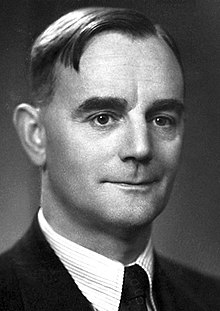Cecil Powell
Cecil Frank Powell (born December 5, 1903 in Tonbridge , Kent , † August 9, 1969 in Bellano on Lake Como ) was a British physicist and Nobel Prize winner .
Life
Cecil Powell was born on December 5th, 1903 as the son of the gunsmith Frank Powell in Tonbridge / Kent. After attending elementary school, he received a scholarship to the Judd School in Tonbridge. With further scholarships, he attended Sidney Sussex College in Cambridge , which he graduated with the Natural Sciences Tripos in 1924/25 . He received his doctorate in 1927 at the Cavendish Laboratory in Cambridge under Charles Thomson Rees Wilson and Ernest Rutherford and then went to the University of Bristol as a research assistant to Arthur M. Tyndall . 1936/37 took part in an expedition in the West Indies , where he used a seismograph to investigate volcanoes. In 1948 he was appointed Melville Wills Professor of Physics in Bristol .
Richard Dalitz was one of his students .
Powell was also politically active in the early days of the Pugwash movement .
Powell married his assistant Isobel Therese Artner in 1932 and had two daughters with her.
plant
Powell's first research at Cavendish Laboratory dealt with condensation phenomena, where he was able to prove the existence of supersaturation in rapidly expanding steam. This discovery had a major influence on the further development and performance improvement of steam turbines .
In Bristol he developed methods for the precise measurement of the mobility of positive ions and was able to prove the type of ions in most of the gases in use. After the Caribbean expedition he worked on the construction of a Cockcroft generator to accelerate protons and deuterons , which he used together with a Wilson cloud chamber to investigate neutron- proton scattering.
From 1938 he also dealt with cosmic rays (at that time the main source of high-energy particles before the development of suitable accelerators) and developed methods to record the particle traces with photographic emulsions . The physicists Marietta Blau and Hertha Wambacher discovered this method for detecting particle traces . Powell later also used these methods to measure the energy of neutrons by means of the recoil protons, in doing so he was able to establish a relationship between energy and track length, which soon found wide applications in experiments on nuclear and particle physics. After a further development of the photographic emulsions he succeeded with Giuseppe Occhialini , Muirhead and others in 1947 the detection of the pion and the muons (then called mesons ) in the cosmic rays as well as the determination of their essential properties. Later it became known, however, that the pion (first proposed theoretically for nuclear power by Hideki Yukawa in 1935) had already been discovered a little earlier in 1947 by Donald H. Perkins of Imperial College in photographic emulsions.
In this context he was director of the European program for altitude research with balloon flights in Sardinia (1952) and in the Po Valley (1954, 1955 and 1957).
Awards
Powell received the Nobel Prize in Physics in 1950 "for the development of the photographic method for studying nuclear processes and the associated discovery of mesons". In 1949 he was elected as a member (" Fellow ") in the Royal Society , which awarded him the Hughes Medal in 1949 and the Royal Medal in 1961 .
When the Nobel Prize was awarded, the Marietta Blau and Hertha Wambacher , whose work Powell knew and used, suggested by Erwin Schrödinger for the same achievement as pioneers in the 1920s and 1930s , were ignored and not even mentioned, although there were considerations, the prize between to share with the pioneers and Powell. Powell didn't mention them in his acceptance speech either. In addition to Lise Meitner, Blau and Wambacher are considered to be lesser-known physicists who have been withheld the Nobel Prize despite their proven achievements.
Other awards:
- Lomonosov Gold Medal , 1967
- Vernon Boys Prize
- Foreign member of the Soviet Academy of Sciences , 1958
- Honorary doctorates from the Universities of Dublin , Bordeaux and Warsaw
- Member of the German Academy of Sciences Leopoldina , 1964
In 1961 he was on the scientific advisory board of CERN .
Fonts
- with Occhialini Nuclear physics in photographs , Clarendon Press 1947
- with Peter Fowler , Donald H. Perkins The study of elementary particles by the photographic method , Pergamon Press 1959
- Lattes, CMG; Occhialini, GPS; Powell, CF: A determination of the ratio of the masses of pi-meson and mu-meson by the method of grain-counting . Proceedings of the Physical Society 61 (1948) p. 173-183
- Lattes, CMG, Muirhead, H., Occhialini, GPS, Powell, CF: Processes involving charged mesons. Nature 159 (1947) 694-697 (Discovery Pion)
literature
- Cecil F. Powell , in: Internationales Biographisches Archiv 37/1969 of September 1, 1969, in the Munzinger Archive ( beginning of the article freely available)
Web links
- Information from the Nobel Foundation on the 1950 award ceremony for Cecil Powell
- Entry for Powell, Cecil Frank (1903-1969) in the Archives of the Royal Society , London
Individual evidence
- ^ Sime, Ruth Lewin: Marietta Blau in the history of cosmic rays. In: Physics today. Retrieved March 5, 2018 .
- ↑ Member entry of Cecil Frank Powell at the German Academy of Natural Scientists Leopoldina , accessed on October 12, 2012.
| personal data | |
|---|---|
| SURNAME | Powell, Cecil |
| ALTERNATIVE NAMES | Powell, Cecil Frank |
| BRIEF DESCRIPTION | English physicist |
| DATE OF BIRTH | December 5, 1903 |
| PLACE OF BIRTH | Tonbridge, Kent |
| DATE OF DEATH | 9th August 1969 |
| Place of death | Bellano on Lake Como |
